Photos of Railroad Locomotives
Early Steam Locomotives
Several early steam locomotives.
Stevens Cog Locomotive
The original Rocket was built by John Stevens in 1825. The wood fueled locomotive operated at 100 psi and was propelled using a cog. These photos are of a replica, built in 1928, currently on display at the Chicago Museum of Science and Industry. (Photos: Richard Kruse, 2009)
Stevens Locomotive Replica


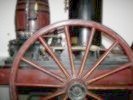

Stephenson's Rocket 0-2-2
The original Rocket was built by Robert and George Stephenson in 1829. The coke fueled locomotive operated at a steam pressure of 50 psi and had a maximum speed of around 29 miles per hour. These photos are of a replica, built in 1931, currently on display at the Chicago Museum of Science and Industry. (Photos: Richard Kruse, 2009)
Rocket Locomotive Replica

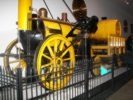





York 0-4-0
The original York was designed by Phineas Davis and built by the Davis and Gartner Foundry in 1829. The coal fueled locomotive operated at a steam pressure of 115 psi and had a maximum speed of around 30 miles per hour. These photos are of a replica, built in 1927, currently on display at the Chicago Museum of Science and Industry. (Photos: Richard Kruse, 2009)
York Locomotive Replica
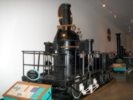







Mississippi 0-4-0
The Mississippi was built in the 1830's. The locomotive was fueled with wood and generated steam pressure of 150 psi. The Mississippi is currently on display at the Chicago Museum of Science and Industry. (Photos: Richard Kruse, 2009)
Mississippi Locomotive

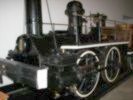





John Bull
Ordered by Robert Stevens for the Camden and Amboy Railroad, the "John Bull" was built in 1831 by the Robert Stevenson & Company of New Castle, England. The locomotive was fueled with wood and attained speeds of 25 to 30 miles per hour. The John Bull is currently on display at the National Museum of American History. (Photos: Richard Kruse, 2009)
John Bull Locomotive







4-4-0 'American' Type Locomotives
'American' type locomotives are identified by having a lead truck with four unpowered wheels, followed by four coupled drive wheels. The 4-4-0 configuration was very common on US railroads in the mid 1800's.
Leviathan 4-4-0 No. 63
Leviathan No. 63 is a recently constructed replica of an 1860's vintage locomotive. For more information, visit the Leviathan Website. These photos were taken in Owosso, Michigan at Train Festival 2009. (Photos: Richard Kruse, 2009)
Leviathan No. 63 at Train Festival, 2009







Leviathan did a Complete Revolution on the Turntable








Empire State Express No. 999
In 1893, engine 999 became the land speed record holder when it reached 112.5 mph. Empire State Express 999 is on permanent display at the Chicago Museum of Science and Industry. (Photos: Richard Kruse, 2009)
Engine 999




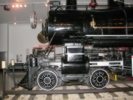





View of Engine 999 from Above




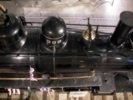

Jupiter 4-4-0 No. 3
Jupiter No. 3 was built in 1876 for the Santa Cruz Railroad. The locomotive was designed to operate on 36" narrow-gauge track. Jupiter was sold to Guatemala after the Santa Cruz Railroad switched to standard gauge track in 1883. The locomotive was restored to its original configuration and place on display for the American bicentennial exhibition in 1976. These photos were taken at the National Museum of American History in Washington D.C.. (Photos: Richard Kruse, 2009)









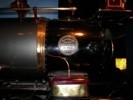
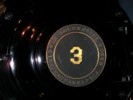

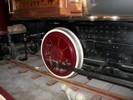



4-6-2 Pacific Type Locomotives
'Pacific' type locomotives are identified by having a lead truck with four unpowered wheels, six coupled drive wheels, and two unpowered trailing wheels. Often used for passenger service, Pacific locomotives were a common sight on American railways during the first half of the 20th century.
Grand Trunk Western No. 5030
GTW-5030 was built by Baldwin Locomotive Works in 1912. The locomotive was involved in a derailment near Durand, Michigan, in 1923. The tragic accident resulted in five deaths and thirty-two injuries. The locomotive was repaired after the accident and was returned to service. The 5030 is currently displayed at the R.A. Greene Park in Jackson, MI. (Photos: Richard Kruse, 2009)
Grand Trunk Western No. 5030

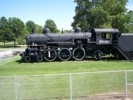


Side Pan




Running Gear



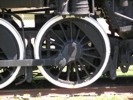
Tender





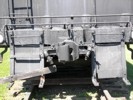
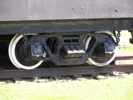
Details

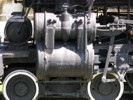

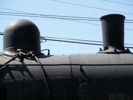

North Carolina No. 1401
Operated by the Southern Railway, the 1401 pulled passenger trains from the mid-1920s until the early 1950s. This historic locomotive pulled President Franklin Roosevelt's funeral train in 1945. In 1951, the "North Carolina" came to the Smithsonian. These photos were taken at the National Museum of American History in Washington D.C.. (Photos: Richard Kruse, 2009)




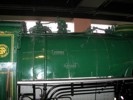




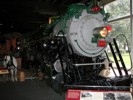

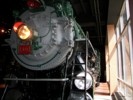
Little River Railroad No. 110
These photos were taken in Owosso, Michigan at Train Festival 2009. (Photos: Richard Kruse, 2009)


Pacific Locomotive Control Cab
Pacific type locomotive control cab on display at the Chicago Museum of Science and Industry. (Photos: Richard Kruse, 2009)
Control Cab Exterior

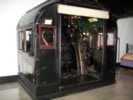

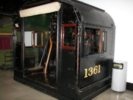
Control Cab Interior
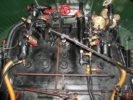




Pacific Locomotive Graphic

Pacific locomotive design available on t-shirts, mugs, mousepads, prints and stickers. The words 'Pacific 4-6-2' surround the locomotive. This image is of the former Grand Trunk Western 5030. The locomotive is currently displayed in Jackson, Michigan. A great gift idea for model railroaders and train enthusiasts!
More Information


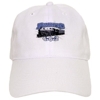
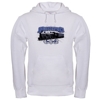

0-4-0T Steam Locomotives
0-4-0 locomotives have four coupled drive wheels, and no lead or trailing wheels. The "T" in the designation indicates that the unit is a "Tank" locomotive. Tank locomotives do not use a tender, as the water and fuel are carried on the locomotive itself.
0-4-0T locomotives are optimized for use as switchers. With all wheels being coupled drive wheels, all the locomotives weight can be used for traction. Without a tender, the locomotive can travel equally well in either direction.
Little River 0-4-0T No.1
Little River 0-4-0T No.1. These photos were taken in Owosso, Michigan at Train Festival 2009. (Photos: Richard Kruse, 2009)
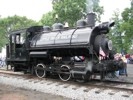




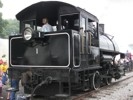
Flagg Coal 0-4-0T No. 75
Flagg Coal 0-4-0T No. 75. These photos were taken in Owosso, Michigan at Train Festival 2009. (Photos: Richard Kruse, 2009)
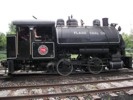

Viscose 0-4-0T No. 6
Viscose 0-4-0T No. 6 steam locomotive. These photos were taken in Owosso, Michigan at Train Festival 2009. (Photos: Richard Kruse, 2009)
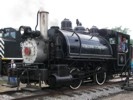

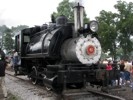


GP38-3
GP38-3. These photos were taken in Jackson, Michigan. (Photos: Richard Kruse, 2009)
Norfolk Southern 5825


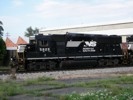
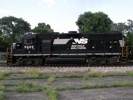
Norfolk Southern 5805
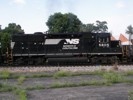
GP40-2W
Huron and Eastern Railway 9712
GP40-2W HESR-9712. These photos were taken in Owosso, Michigan at Train Festival 2009. (Photos: Richard Kruse, 2009)



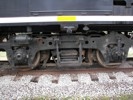
MP36PH-3S
MP36PH-3S locomotives are manufactured by MotivePower. A 16 cylinder diesel engine provides traction power as well as HEP (Head End Power). Of the 3600HP produced, 2930HP is available for traction. Chicago Metra purchased 27 of these units during 2003 and 2004.
Metra 425
Metra 425. These photos were taken near Chicago Union Station. (Photos: Richard Kruse, 2006)


Metra 423
Metra 423. These photos were taken near Chicago Union Station. (Photos: Richard Kruse, 2006)

F40PHM-2
F40PHM-2 operated by Chicago Metra. These photos were taken near Chicago Union Station. (Photos: Richard Kruse, 2006)
Metra 210
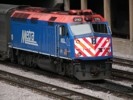

Metra 214
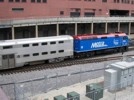
P-42 Amtrak
P-42 locomotives are used extensively by Amtrak and VIA. Built by General Electric, the P-42 is capable of speeds up to 110 mph.
Amtrak 87
Amtrak P-42 locomotive leaving Chicago Union Station. (Photos: Richard Kruse, 2006)



Amtrak 21 and 203
Amtrak 21 and 203 pulling a Superliner train-set approaching Chicago Union Station. (Photos: Richard Kruse, 2009)


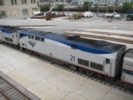


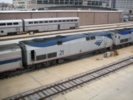

Amtrak 34
Photos of Amtrak 34, pulling the Wolverine thru Jackson, Michigan. (Photos: Richard Kruse, 2009)




EMD SW8 Switching Locomotive
The EMD SW8 is a diesel switching locomotive manufactured by General Motors Electro-Motive Division (EMD) and General Motors Diesel (GMD). 374 units were produced between 1950 and 1954. SW8 locomotives are powered by an eight cylinder diesel power-plant producing 800 horsepower.
EMD SW8 U.S. Air Force 2021
A SW8 switcher formally used by the United States Air Force at Cape Canaveral Air Force Station. This was one of three SW8 locomotives (road numbers 2000, 2007, and 2021) used to support the Titan IV launch complex (SLC-40), including moving of solid rocket booster segments and towing fully assembled Titan IV rockets to the launch pad. This switcher is now on display at the Air Force Space and Missile Museum. (Photos: Richard Kruse, 2009)



Railroad T-shirts and Gifts
A variety of train designs available on t-shirts, sweatshirts, hats, and other products. Great gift ideas for railroad workers, model railroaders, and railfans.

Find dozens of railroad themed gifts at History and Science T-shirts and Gifts.
Steam Locomotive Types
(Whyte Notation)
Whyte notation was developed by Frederick Whyte and is one of the most common systems for classifying steam locomotives.
The system used a series of numbers, separated by dashes, counting the number of wheels. The first digit counted the number of lead wheels, the middle numbers counted coupled drive wheels, the final number counted trailing wheels.
2-2-0 Planet
0-4-0 Four-Wheels
2-4-2 Columbia
4-4-0 American
4-4-2 Atlantic
4-4-4 Reading
2-6-0 Mogul
2-6-2 Prairie
4-6-0 Ten-Wheeler
4-6-2 Pacific
4-6-4 Hudson
2-8-0 Consolidation
2-8-2 Mikado
2-8-4 Berkshire
4-8-4 Northern
2-10-0 Decapod
2-10-2 Santa Fe
2-10-4 Texas
4-10-0 Mastodon
4-10-2 Overland
2-6-6-6 Allegheny
4-6-6-4 Challenger
4-8-8-4 Big Boy
Railroad Abbreviations
Reporting Marks for Selected North American Railroads
Class I Railroads
BNSF Burlington Northern and Santa Fe
CN Canadian National
CP Canadian Pacific
CSX CSX Transportation
FXE Ferrocarril Mexicano
KCS Kansas City Southern
KCSM Kansas City Southern de Mexico
NS Norfolk Southern
UP Union Pacific
Other Railroads
AA Ann Arbor
AMTK Amtrak
ACL Atlantic Coast Line
B&O Baltimore and Ohio
C&O Chesapeake and Ohio
CR Conrail
EL Erie Lackawanna
GTW Grand Trunk Western
IC Illinois Central
MC Michigan Central
NYC New York Central
PRR Pennsylvania Railroad
SBD Seaboard System
SAL Seaboard Air Line
SCL Seaboard Coast Line
SOO Soo Line
SP Southern Pacific
VIA VIA Rail Canada
WM Western Maryland Railway
WP Western Pacific



















































































































































































